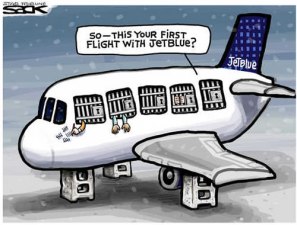by Sergio Ramírez, Lesly Martínez & Pablo Camargo
Many people are surprised when they find out there is (or should be) a communication department in every organization they may name. Truth be told, these guys work hard to keep the company running smoothly, yet they are not what the buzz is about until chaos comes around.
When companies are in front a crisis they try to fix it immediately, but not in all of the cases the stakeholders will understand the way the companies apologize to them. Noteven top-tier brands are exempt of being involved in a crisis, and though the communications area is there to help prevent this from happening in the first place, it is also its job to handle it swiftly and successfully once it occurs. It’s important to know how to address the problem if the company doesn’t want to cause more damage to their own brand, reputation and the way the stakeholders look at them. Be it people finding worms in their chocolate bars, being stuck in an airport for a week, or even just a hoax played on the company, the PR team is up for the job.
Next, we present to you three cases of crises that took place in the past, handlings of which were not always the most suitable for the situation. However, this is where you and we come in, to learn from their mistakes and apply these insights to your very own companies.
-
Cadbury
Back in 2003, Cadbury’s famous Dairy Milk Chocolate Bars jumped into the spotlight when worms were found within a number of them in India. After this incident, the company took a series of steps to prevent the issue from growing: They stopped the nearest plant and rushed to release a statement claiming that the growth must have sprung due to retail management issues, as it was not possible for the worms to be developed at a production stage. This was the reason why Cadbury released a series of videos aimed to retailers, in order to ensure correct handling of their product in stores.

However, after being in the public eye for a couple months with a loss of 30% in sales, Cadbury opted for a change, core and image-wise. The company acquired new machinery for the India plant, and with it came a change in the packaging of the product. This actions helped Cadbury’s reputation get back on track, and after only 10, their numbers began to be almost as those of before the crisis.
What can we learn from this?
First of all, the Comm team at Cadbury was very efficient at identifying the problem and releasing a statement on it. However, they should have just acted instead of trying to make sure everyone knew the retailer was the faulty step in the chain. It’s OK, but nobody likes a teller.

Yet, they were fast to understand that changes are (most of the times) for the better, and this visual change in the packaging helped them regain the trust of their customers. It was not only about the new image but what it meant: a new, revised, freshly processed chocolate bar that ensures no worms are inside.

Discover more about Cadbury’s case:
- From the news: Cadbury recovers from worm shock
-
Wendy’s
Selling food is a difficult tree to climb, as there are lots of regulations and standards to fulfil l, and hence, one of the easiest branches for customers to sue against. The ginger-haired fast-food chain was one to suffer from a fingery situation during March of 2005, as a woman claimed to have found a severed tip of a finger in her chili bowl.
l, and hence, one of the easiest branches for customers to sue against. The ginger-haired fast-food chain was one to suffer from a fingery situation during March of 2005, as a woman claimed to have found a severed tip of a finger in her chili bowl.
Wendy’s immediately got its hands on the job and made sure that the chili was examined in order to corroborate whether the finger was planted or, to put it in a way, legit. Turns out the whole thing was just a hoax, and the chili was human flesh-free. Great for the company, right? Well, not altogether. Even though Wendy’s found the claim to be false, the company failed to communicate this to its stakeholders.
Steps were never taken on the chili issue. The brand never really came clean to the customers, nor retired the item from the menu as an attempt to re-gain trust from the guests. These actions made it look as if the incident was not worth of further examination or seriousness.
As a result, the fast-food chain lost around 21 million USD in less than a month. Workers had to be fired and store hours had to be cut due to low sales, mainly in California franchises. 
What can we learn from this?
First of all, you must have very clear who comes first, that is YOUR CUSTOMERS (stakeholders in general). The one with the harmed reputation is the company, indeed, however, the ones who can help you get it back is not other than your customers.
Hoax or not, your company should have a constant communication flow with the stakeholders, making them feel heard and taken into account (This not only applies to verbal communication but extends to your actions; Wendy’s failed to show its customers that their worries and safety were important for the brand as it did not do anything with the chili nationwide).
Discover more about Wendy’s case:
- Video: Meet the woman behind the hoax
- News: The whole story
- News: Whose finger was it anyway?
-
JetBlue
 In 2007, one of the most important airlines of the United States, JetBlue, was forced to cancel 1,000 flights during five days after an ice storm hit the East Coast. This situation brought an important crisis to the airline, which affected plenty of people who got equally angry and disappointed. As a response to the situation, the CEO of JetBlue not only did not blame the weather but also he wrote a public letter to apologize to the customers. The letter promised that the company would have monetary compensation, sales and presented a customer’s bill of rights.
In 2007, one of the most important airlines of the United States, JetBlue, was forced to cancel 1,000 flights during five days after an ice storm hit the East Coast. This situation brought an important crisis to the airline, which affected plenty of people who got equally angry and disappointed. As a response to the situation, the CEO of JetBlue not only did not blame the weather but also he wrote a public letter to apologize to the customers. The letter promised that the company would have monetary compensation, sales and presented a customer’s bill of rights.
Although David Neeleman, JetBlue’s CEO, wrote the public letter, he decided to speak on Youtube, The Today Show, Letterman and Anderson Cooper, apologizing about the fault the company had. Though the airline lost sales and customers, the job they did with the customer service made a difference among the competitors.

What can we learn from this?
Even when the main problem that caused JetBlue’s crisis was a natural phenomenon, it’s considerable to recognize the CEO’s honesty. He knew that the decision was taken because of the ice storm, but equally was taken in order to take care of the customers and employees safety. In many occasions, the companies think that the decisions they take will bring benefits instead of chaos, in this case, JetBlue made the right move, they just were not as great making it look that way, and thus lost many customers.
What we learn with the situation of JetBlue is that the best way to getting out of a crisis is sharing with the customers, employees, and stakeholders the good service and job that distinguishes the company of the competitors.
Discover more about JetBlue’s case:
- News: The whole story
- From JetBlue: Read David Neeleman’s Statement
- Video: JetBlue’s CEO addresses customers
Above we shared three stories of company crises that prove that there is no small challenge when it comes to handling issues regarding communication. Whether they were solved correctly is yours to say, but we want to sum up a couple things from these examples that can be vital in any situation:

So there you have it, a fresh batch of tips and tricks to take into account for whenever should you deal with a crisis. In any case, remember that your goal as part of the communication department is to COMMUNICATE, so go out and do so effectively.
References:
- McCown, A., & McCown, S. (2017). Lessons Learned From the Top PR Crises of 2016. february 13, 2017, from PRNews For Smart Communicators Web: http://www.prnewsonline.com/lessons-learned-from-the-top-pr-crises-of-2016/
- Bernstein, J. The 10 Steps of Crisis Communication. Bernstain Crisis Management. 2016. Web: <http://www.bernsteincrisismanagement.com/the-10-steps-of-crisis-communications/>
- Bhasin,K. (2011).9 PR Fiascos That Were Handled Brilliantly by Management. february 13, 2017, from Business Insider Web: <http://www.businessinsider.com/pr-disasters-crisis-management-2011-5>
- Anonymous(2016). The Top 12 Crises of 2015. february 13, 2017, from The Holmes Report. Web: <http://www.holmesreport.com/long-reads/article/the-top-12-crises-of-2015-part->
- Anonymous(no year).22 Biggest Crisis Communications Challenges in Restaurant History. february 13, 2017, from The Holmes Report. Web: <http://aaronallen.com/blog/21-biggest-crisis-communications-challenges-in-restaurant-history >
